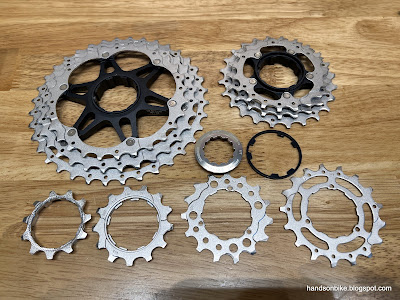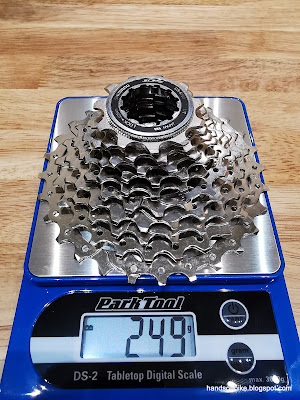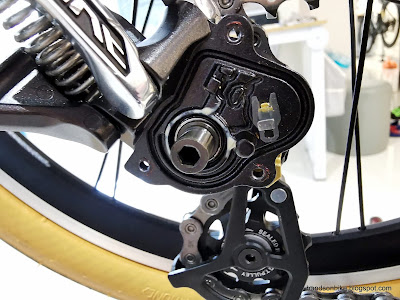When I was deciding on the drivetrain to use on the Bestrider Pump Pro 20, there are many considerations, since this is a kids bike. The stock drivetrain has a 8 speed semi-Shimano drivetrain, which is actually pretty good for kids bikes. However, I wanted something nicer than the 8 speed drivetrain.
On the previous Bestrider Pump Pro 16 kids bike, I took extra effort to make sure that the 3 speed drivetrain is easy to use even for kids. It was a unique, one-of-a-kind 3 speed drivetrain for 16 inch kids bikes. Now, on this new 20 inch kids bike, the shifters will be changed from the Revoshifter (good for small hands) to a more standard trigger shifter.
One of the prerequisite to operate a trigger shifter is a hand size that is big enough and strong enough to push the shifting levers. Usually, this only becomes feasible from the age of 6 onwards.
Another important feature for kids is the Optical Gear Display (OGD) on the shifter. This helps them to know which gear they are in, and understand how to shift gears depending on the terrain. Problem is, many high end flat handlebar shifters (such as 11 speed road or MTB shifters) do not come with OGD. Whereas for other shifters such as the Sora 9 speed shifter, it has an OGD but no numbers on it, which is basically pointless. The stock Shimano Altus SL-M310 8 speed shifter is actually good because it has gear numbers clearly shown on the OGD.
If possible, the shifting force and shifting stroke for kids should be minimized, to make it easier for their small hands and short fingers to push the shifting levers. From what I know, to have shorter shifting stroke, a high end shifter such as Deore XT or XTR will be ideal. At the same time, the shifting force will also be lower as the construction uses sealed bearings inside for smoother operation.
Thus, I was looking for the best shifter that fulfills all these conditions:
1) Light shifting force
2) Short shifting stroke
3) Optical Gear Display with numbers
The ideal candidate for this is thus the Deore XT SL-T780 Trekking 10 Speed Shifter. This model has been out of production for many years, but I still have it from old stock. It was first used on the Polygon Cozmic CX3.0 MTB, then the United Trifold when I was experimenting with multi-speed drivetrains.
Deore XT SL-T780 Trekking Shifter for 10 speed MTB drivetrains. Rare item nowadays!
I like that each gear position is accurately indicated by a silver line.
Premium aluminium lever. It has Instant Release, 2-Way Release, and Multi-Release features, which is not necessary.
Weighs 126 grams without the shifter inner cable.
Since I have decided to go with this 10 speed shifter, I have to find the other 10 speed components to match the shifter. This includes a 10 speed cassette, 10 speed MTB rear derailleur, and a 10 speed chain. It is harder to find high end 10 speed MTB components nowadays, since MTB drivetrains have mostly moved to 11 and 12 speeds a few years ago.
Therefore, once again I need to look towards older models for high end 10 speed components. 10 speed MTB components are available at a few levels, such as Deore, SLX and Deore XT. I chose to get a Deore XT cassette to save a bit of weight, and to have a more corrosion resistant cassette.
Deore XT CS-M771-10, which is a 10 speed cassette. I got the 11-36T cassette for a wider gear range, and to be compatible to the rear derailleur as shown below.
Nice and shiny new cassette! I like the sand blasted finish which gives it a premium look.
Larger sprockets are 36T, 32T, 28T and 24T, which are nice gear steps.
Being a Deore XT cassette, the largest 6 sprockets are mounted on 2 aluminium spiders to save weight.
Close up look at the larger sprocket set, with 28-32-36T sprockets.
Next 3 sprockets are also mounted on a spider to save weight.
Entire 11-36T 10 speed cassette weighs 308 grams, which is pretty good.
In order to match the 10 speed shifter that I have chosen, I need to find a compatible 10 speed rear derailleur. As the shifter is a MTB / Trekking type of shifter, I need to use a MTB or Trekking 10 speed rear derailleur, due to the cable pull ratio.
If I just get a standard 10 speed MTB rear derailleur, the cage will be too long for small wheel bikes. A 10 speed road rear derailleur such as Tiagra or the older 105 is not compatible, which is a shame since those road rear derailleurs have short cages which are ideal for small wheel bikes.
Using my previous experience with the United Trifold, I know that there are short cage 10 speed MTB rear derailleurs, such as the Shimano Saint or Zee. I no longer have the Saint rear derailleur, so I had to buy a new one. Decided to get the Zee rear derailleur instead, and managed to find a brand new unit even though it has already been discontinued.
Shimano Zee RD-M640-SS Short Cage 10 speed rear derailleur. There are two specifications, and I needed the one with a larger 36T rear sprocket compatibility to match the 11-36T cassette.
Brand new Zee rear derailleur! Shadow construction for a low side profile.
Uses a stamped inner link, instead of an aluminium version on the Saint rear derailleur.
It is also equipped with a one-way clutch with on-off switch, to minimize chain slap on bumpy terrain.
Check out the super short cage! Only compatible with front single drivetrains.
Cage length is only 50 mm from pulley to pulley, which is way shorter than even Dura-Ace and Ultegra road rear derailleurs.
Weight is 267 grams, which is pretty chunky for a short cage. This is due to the beefy construction to make the derailleur more resistant to knocks and bumps.
I realized that there is no need for the one-way clutch feature, since this kids bike is not going off-road on bumpy terrain. Same as what I did for the Saint rear derailleur on the United Trifold, I also removed the clutch unit.
The one-way clutch parts can be removed, leaving this area empty. It will still work perfectly fine, just without the clutch feature.
Clutch parts removed from the Zee rear derailleur.
After removing the clutch parts, about 16 grams is saved. Weight is reduced to 251 grams.
Main purpose of removing the clutch is not to save weight, although that is a nice bonus. Rather, the main objective is to reduce the shifting force. As the clutch inadvertently provides resistance during inwards shifting, this translates to a higher shifting force. By removing the clutch, the rear derailleur cage is able to rotate more freely, with just the spring force and no clutch resistance. The result is lighter shifting force at the shifter, which is the main objective.






















































